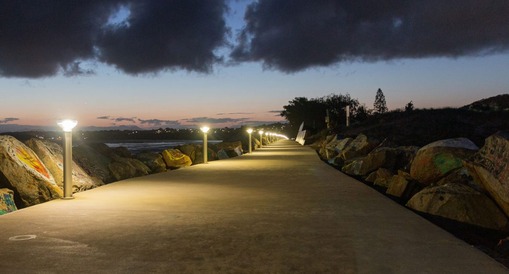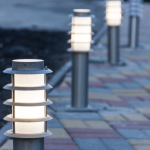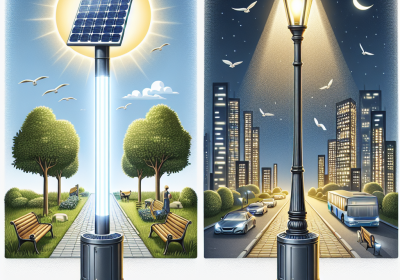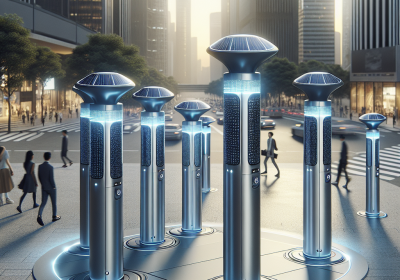Eco-Friendly and Efficient: How Solar Bollards Are Shaping Australia’s Green Cities
In the bustling metropolises of Australia, where skyscrapers reach for the heavens and city lights twinkle like stars, a quiet revolution is taking place. As concerns about environmental degradation and climate change loom large, the quest for sustainable urban solutions has never been more urgent. Enter solar bollards – the unsung heroes of Australia’s green cities. These unassuming pillars of light are quietly illuminating pathways, parks, and streets, all while harnessing the power of the sun. But how exactly are these solar bollards shaping Australia’s urban landscape? Let’s dive in and shed some light on this eco-friendly innovation.
The Need for Sustainable Urban Solutions

Picture this: towering skyscrapers casting long shadows over crowded streets, while exhaust fumes choke the air. It’s a scene straight out of a dystopian nightmare, yet it’s a reality for many urban dwellers around the world. With the specter of climate change looming large, the importance of sustainable urban planning and development has never been more critical. From reducing carbon emissions to preserving precious natural resources, the need for eco-friendly solutions is paramount. And that’s where solar bollards come into play.
Tips for Implementing Solar Bollards in Urban Environments:
- Conduct a thorough site assessment to identify optimal locations for solar bollard installation, taking into account factors such as sunlight exposure, foot traffic patterns, and aesthetic considerations.
- Choose high-quality solar bollards with durable construction and weather-resistant features to ensure longevity and performance in diverse environments.
- Consider integrating additional features such as motion sensors or dimming capabilities to maximize energy efficiency and enhance user experience.
- Engage with stakeholders, including local government officials, residents, and businesses, to garner support for solar bollard initiatives and address any concerns or questions.
- Implement a regular maintenance schedule to clean solar panels, inspect batteries, and troubleshoot any issues to ensure optimal performance and longevity of solar bollards.
- Explore funding opportunities such as government grants or rebates to offset the upfront costs of solar bollard installation and make them more financially viable for municipalities and organizations.
- Educate the community about the benefits of solar bollards, including energy savings, reduced carbon emissions, and enhanced safety and security, to foster greater acceptance and adoption.
Understanding Solar Bollards
So, what exactly are solar bollards? Imagine a traditional bollard – a sturdy post typically used to guide traffic or mark boundaries. Now, add a dash of solar magic, and voila! You have a solar bollard. These ingenious devices harness sunlight during the day and convert it into electricity, which is then stored in batteries for use at night. With no need for external power sources or wiring, solar bollards offer unparalleled flexibility in installation and maintenance. Plus, they come equipped with a plethora of design features, from motion sensors to dimming capabilities, making them ideal for a variety of urban environments.
But what sets solar bollards apart from their traditional counterparts? For starters, they’re incredibly energy-efficient, thanks to their reliance on renewable solar power. This not only reduces electricity bills but also decreases carbon emissions, making them a win-win for both the environment and the pocketbook. Additionally, solar bollards boast a minimal environmental footprint, with no greenhouse gas emissions or light pollution to speak of. And let’s not forget about their cost-effectiveness – with no ongoing energy costs or maintenance fees, they’re a smart investment for cash-strapped cities looking to tighten their belts.
Solar Bollards in Australian Cities
Now that we’ve covered the basics, let’s take a closer look at how solar bollards are making waves in Australian cities. From the iconic streets of Sydney to the cultural hub of Melbourne and the sunny shores of Brisbane, solar bollards are cropping up everywhere you look. But don’t just take our word for it – let’s delve into some real-world examples.

In Sydney, the city’s commitment to sustainability is on full display with the installation of solar bollards along popular waterfront promenades and pedestrian thoroughfares. Not only do these bollards provide much-needed illumination after dark, but they also serve as a visible reminder of the city’s dedication to renewable energy.
Meanwhile, in Melbourne, solar bollards are lighting up parks and green spaces, creating safe and inviting environments for residents and visitors alike. Whether you’re strolling through the Royal Botanic Gardens or picnicking in Federation Square, you’re sure to encounter these eco-friendly beacons of light.
And let’s not forget about Brisbane, where solar bollards are helping to transform the city’s riverfront into a vibrant hub of activity. From the bustling South Bank precinct to the tranquil Kangaroo Point cliffs, these bollards are illuminating pathways and bike trails, encouraging residents to embrace a more sustainable mode of transportation.
Interesting Facts About Solar Bollards:
- Solar bollards can reduce carbon emissions by up to 100 tons per year for every 1000 bollards installed, making them a significant contributor to greenhouse gas reduction efforts.
- The average lifespan of a solar bollard is approximately 10 years, making them a durable and long-lasting investment for urban infrastructure projects.
- Solar bollards can provide up to 10 hours of illumination on a single charge, ensuring reliable lighting throughout the night without the need for external power sources.
- The installation of solar bollards can lead to significant cost savings over time, with studies showing up to 80% reduction in energy costs compared to traditional grid-powered lighting solutions.
- Solar bollards are highly versatile and can be installed in a wide range of urban environments, including parks, bike paths, pedestrian walkways, and public squares.
- Solar bollards are equipped with LED lights, which are up to 80% more energy-efficient than traditional incandescent bulbs, further enhancing their eco-friendly credentials.
- Solar bollards can enhance safety and security in urban areas by providing reliable illumination during power outages or emergencies, helping to reduce the risk of accidents and crime.
Challenges and Limitations with solar bollards
Of course, no innovation comes without its challenges, and solar bollards are no exception. From initial cost barriers to performance concerns in certain environments, there are several obstacles standing in the way of widespread adoption. Additionally, public perception and acceptance play a crucial role in the success of solar bollards, with some residents expressing skepticism or resistance to change.
But fear not – there are strategies in place to overcome these challenges. Government incentives and subsidies can help offset the upfront costs of installation, making solar bollards more accessible to cash-strapped municipalities. Likewise, ongoing technological advancements and research are improving the performance and reliability of solar bollards, addressing concerns about their efficacy in diverse environments. And let’s not underestimate the power of public awareness and education campaigns, which can help dispel myths and misconceptions about solar technology, paving the way for greater acceptance and adoption.
Future Outlook and Potential Innovations with solar bollards
Looking ahead, the future of solar bollards is brighter than ever. With emerging trends in technology and design, these humble pillars of light are poised to play an even greater role in shaping Australia’s green cities. Imagine solar bollards equipped with advanced sensors and connectivity features, seamlessly integrating with smart city initiatives to create safer, more efficient urban environments. Or envision a future where solar bollards are not only lighting our streets but also powering our homes and businesses, ushering in a new era of energy independence and sustainability. The possibilities are endless.
In closing solar bollards are more than just a practical solution to urban lighting – they’re a symbol of Australia’s commitment to sustainability and innovation. By harnessing the power of the sun, these eco-friendly beacons are illuminating the path towards a greener, brighter future for all. But their success depends on us – on our willingness to embrace change, to invest in renewable energy, and to build a more sustainable world for generations to come. So let’s join hands and shine a light on the power of solar innovation – because when it comes to shaping Australia’s green cities, the sky’s the limit.
FAQs
Q: Are solar bollards reliable in inclement weather?
A: Yes, modern solar bollards are designed to withstand a variety of weather conditions, including rain, wind, and extreme temperatures. However, it’s essential to choose high-quality, weather-resistant bollards for optimal performance.
Q: How long do solar bollards last?
A: The lifespan of solar bollards can vary depending on factors such as usage, maintenance, and environmental conditions. On average, solar bollards can last anywhere from 5 to 10 years or more with proper care and upkeep.
Q: Can solar bollards be installed in remote or off-grid locations?
A: Yes, one of the main advantages of solar bollards is their ability to operate independently of external power sources. This makes them ideal for use in remote or off-grid locations where access to electricity may be limited or unavailable.
References:
- Clean Energy Council. (2022). Renewable energy in Australia.
- Australian Government Department of the Environment and Energy. (2022). Australia’s emissions projections 2022.
- City of Sydney. (2022). Sustainable Sydney 2030.
- https://orcasolarlighting.com.au/solar-bollard-lighting
Read more about commercial solar street lights
Illuminating the Path: The Rise of Commercial Solar Bollards in Australian Landscapes
Cost Analysis: The Long-Term Savings of Solar Bollards Over Traditional Lighting Solutions
Innovation in Illumination: The Latest Technologies in Solar Bollard Design
The Role of Solar Bollards in Australia’s Varied Climates
Regulatory Insights: Compliance and Standards for Installing Solar Bollards in Australia
Public Perception and Acceptance: Community Responses to Solar Bollards in Urban Areas
The Future of Outdoor Lighting: Predictions for Solar Bollards in the Next Decade








